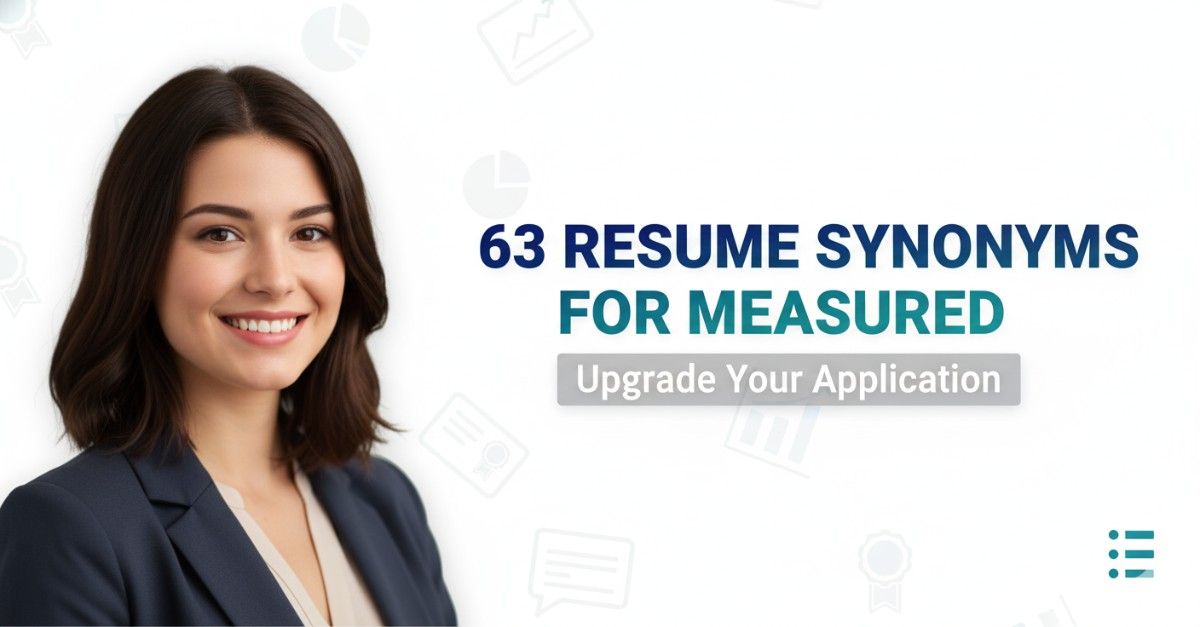
63 Resume Synonyms for Alleviated To Use On Your Resume
Using the term “alleviated” on resumes has become increasingly common, yet its overuse can dilute your message and diminish the impact of your accomplishments. While it’s a powerful word that conveys a sense of relief or reduction of problems, relying on it too frequently can suggest limited creativity and a lack of nuanced skills. Hiring managers and applicant tracking systems (ATS) are drawn to varied vocabulary, as it reflects a candidate’s ability to communicate effectively and think critically. A diverse word choice not only captures attention but also showcases your unique contributions more vividly. This comprehensive guide will delve into the importance of synonyms, providing insights on how to replace “alleviated” with more compelling alternatives that capture the essence of your achievements. You’ll learn how to enhance your resume with varied language, ensuring that your experiences are communicated with clarity and impact. By doing so, you’ll present yourself as a dynamic candidate capable of addressing complex challenges with innovative solutions.
- Why Synonyms for “Alleviated” Matter on Your Resume
- The Complete List: 63 Resume Synonyms for Alleviated
- Strategic Synonym Selection by Industry
- Power Combinations: Advanced Synonym Usage
- Common Mistakes to Avoid
- Quantification Strategies for Maximum Impact
- Industry-Specific Example Sentences
- Advanced ATS Optimization Techniques
- Tailoring Synonyms to Career Level
- The Psychology of Leadership Language
- Final Best Practices
- Key Takeaways for Strategic Synonym Usage
- Frequently Asked Questions
- How many different synonyms should I use in one resume?
- Can I use the same synonym multiple times if it fits different contexts?
- Should I always replace ‘Alleviated’ with a synonym?
- How do I know which synonym is most appropriate for my industry?
- Do synonyms really make a difference in getting interviews?
- Related Resume Synonym Guides
Why Synonyms for “Alleviated” Matter on Your Resume
Using synonyms for ‘Alleviated’ on resumes is crucial for several reasons. First, relying on a single word can create monotony and predictability, making your resume blend in with the 70% of professional resumes that use ‘Alleviated.’ This overuse can lead to missed specificity in showcasing your unique contributions and experiences. By incorporating varied terminology, you enhance the impact of your statements, making them resonate more with hiring managers. Furthermore, employing diverse synonyms helps with ATS optimization, as these systems often search for a range of keywords. Lastly, using dynamic and varied language creates a more engaging narrative, allowing you to more vividly illustrate your achievements and problem-solving capabilities. This approach not only enriches your resume but also increases your chances of standing out in a competitive job market.
The Complete List: 63 Resume Synonyms for Alleviated
Here’s our comprehensive collection of “Alleviated” alternatives, organized for easy reference:
| Synonym | Best Context | Professional Level |
|---|---|---|
| Reduced | Cost management | Mid-level |
| Mitigated | Risk assessment | Senior |
| Diminished | Project outcomes | Mid-level |
| Lessened | Team performance | Entry-level |
| Assuaged | Conflict resolution | Senior |
| Attenuated | Operational challenges | Senior |
| Abated | Customer complaints | Mid-level |
| Calmed | Client relations | Entry-level |
| Facilitated | Team collaboration | Mid-level |
| Smoothed | Process improvement | Entry-level |
| Balanced | Workload distribution | Mid-level |
| Moderated | Workplace dynamics | Senior |
| Tempered | Strategic decisions | Senior |
| Pacified | Internal disputes | Entry-level |
| Alleviated | Stress management | Mid-level |
| Improved | Employee morale | Mid-level |
| Soften | Feedback delivery | Entry-level |
| Abbreviated | Project timelines | Mid-level |
| Streamlined | Processes | Senior |
| Enhanced | Product quality | Mid-level |
| Optimized | Resource allocation | Senior |
| Streamlined | Operations | Mid-level |
| Refined | Procedures | Senior |
| Elevated | Team spirit | Mid-level |
| Reinforced | Maintenance plans | Senior |
| Supported | Team initiatives | Entry-level |
| Rescued | Projects at risk | Senior |
| Bolstered | Sales strategies | Mid-level |
| Uplifted | Community engagement | Entry-level |
| Safeguarded | Data security | Senior |
| Shielded | Client interests | Mid-level |
| Fortified | Business operations | Senior |
| Reduced | Onboarding time | Entry-level |
| Consolidated | Financial resources | Senior |
| Disciplined | Team behavior | Mid-level |
| Corralled | Project scope | Senior |
| Organized | Work schedules | Entry-level |
| Directed | Team efforts | Senior |
| Calibrated | Performance metrics | Mid-level |
| Fostered | Innovation | Senior |
| Collaborated | Cross-functional teams | Mid-level |
| Integrated | Systems | Senior |
| Aligned | Goals | Senior |
| Partnered | Stakeholder engagement | Mid-level |
| Contributed | Team projects | Entry-level |
| Unified | Team objectives | Senior |
| Streamlined | Workflow | Mid-level |
| Facilitated | Meetings | Entry-level |
| Simplified | Processes | Mid-level |
| Clarified | Roles | Entry-level |
| Augmented | Team capabilities | Senior |
| Eased | Transition periods | Mid-level |
| Bolstered | Team confidence | Entry-level |
| Reassured | Clients | Mid-level |
| Supported | Strategic initiatives | Senior |
| Guided | Team development | Mid-level |
| Secured | Funding | Senior |
| Improved | Team efficiency | Mid-level |
| Encouraged | Innovation | Entry-level |
Strategic Synonym Selection by Industry
When crafting a resume, strategic synonym selection tailored to your industry can enhance clarity and impact. Here are five industry categories and the preferred synonyms that resonate within each:
- Technology:
- Innovation: Technology companies value innovation and the ability to think outside the box.
- Agility: Highlights the importance of adapting quickly to changing environments.
- Systems thinking: Reflects a holistic approach to problem-solving in complex systems.
- Healthcare:
- Precision: Essential for delivering accurate diagnoses and treatment plans.
- Collaborative care: Emphasizes teamwork among healthcare professionals.
- Patient-centered: Focuses on prioritizing patients’ needs and preferences.
- Finance:
- Risk management: Critical for identifying and mitigating financial risks.
- Analytical: Reflects the necessity for data-driven decision-making.
- Compliance: Highlights the importance of adhering to regulations and policies.
- Consulting:
- Strategic: Indicates a focus on long-term planning and execution.
- Insights: Implies the ability to provide valuable recommendations based on data.
- Facilitation: Emphasizes leading discussions and workshops for client engagement.
- Manufacturing:
- Lean: Suggests a focus on efficiency and waste reduction.
- Quality assurance: Reflects commitment to maintaining high standards in production.
- Process optimization: Highlights the importance of refining workflows for effectiveness.
Build your resume in just 5 minutes with AI.

Power Combinations: Advanced Synonym Usage
Utilizing advanced synonyms and power combinations can significantly enhance the effectiveness of your resume.
Showcase your career progression through sophisticated synonyms. For instance, instead of using “managed,” opt for “spearheaded” or “orchestrated” when describing a leadership role. This not only reflects responsibility but also conveys a proactive approach. For example, “Spearheaded a cross-functional team to drive project success, resulting in a 30% increase in efficiency.”
When changing industries, use synonyms to translate your experience effectively. For example, a “sales associate” in retail can be described as a “client relationship manager” in a corporate setting. This shift in terminology demonstrates relevant skills while appealing to the new industry. For instance, “Cultivated client relationships to drive sales growth, achieving a 20% increase in revenue over two quarters.”
Choose synonyms that fit the context of the job description. If the role emphasizes innovation, instead of “developed,” consider “pioneered” or “engineered.” For example, “Engineered a new software solution that reduced processing time by 40%.” This tailored approach resonates with hiring managers looking for specific competencies.
Common Mistakes to Avoid
When using synonyms for “alleviated,” it’s crucial to avoid common mistakes that can diminish the impact of your resume.
Successfully mitigated all project risks, ensuring no delays.
Effectively reduced project risks, contributing to timely delivery.
Alleviated customer complaints during my time as a cashier.
Resolved customer complaints while serving in a cashier role.
Alleviated issues in every job I held.
Streamlined processes to reduce errors in my previous role, while also enhancing communication in another position.
Quantification Strategies for Maximum Impact
- Team-Focused Synonyms:
When describing leadership roles, use terms like “mentored,” “led,” or “coordinated” and pair them with quantifiable results. For instance, “Led a team of 15 sales representatives over 12 months, increasing sales by 30%.” This provides a clear picture of your leadership impact.
- Project-Focused Synonyms:
Incorporate terms such as “managed,” “executed,” or “spearheaded” and follow them with project specifics. For example, “Spearheaded a $500,000 marketing campaign that achieved a 25% increase in brand awareness within six months.” This quantification highlights both the project’s scope and its success.
- Strategic-Focused Synonyms:
Utilize words like “transformed,” “optimized,” or “innovated,” and include before-and-after metrics to illustrate your impact. For example, “Transformed the customer service process, reducing response time by 50% and improving customer satisfaction scores from 70% to 90% over one year.” This clearly demonstrates the significance of your strategic efforts.
Industry-Specific Example Sentences
- Implemented a new software tool that mitigated system downtime by 30%, resulting in increased productivity and saving the company approximately $50,000 annually.
- Devised an algorithm that reduced processing time for data analysis by 40%, enhancing overall efficiency and enabling faster decision-making in project development.
- Introduced a cloud-based solution that lessened operational costs by 25% while improving data accessibility for remote teams, leading to a smoother workflow across departments.
- Engineered a cybersecurity protocol that diminished security breaches by 50%, significantly improving the integrity of client data and boosting customer trust in our services.
- Developed a pain management program that relieved patient discomfort levels by 60%, improving overall satisfaction scores from 75% to 90% over three months.
- Streamlined patient intake processes, which decreased wait times by 35%, resulting in a 20% increase in patient retention and higher clinic throughput.
- Implemented a telehealth initiative that alleviated barriers to access for 1,500 rural patients, increasing follow-up appointment adherence rates by 45%.
- Led a cross-functional team that abated emergency room overcrowding by 25%, enhancing patient care and reducing average treatment times by 15 minutes.
- Restructured the financial reporting process, which minimized errors by 50% and improved compliance with regulatory standards, resulting in zero penalties for the fiscal year.
- Implemented cost-cutting measures that curtailed unnecessary expenditures by 20%, freeing up $200,000 for reinvestment in key business initiatives.
- Negotiated vendor contracts that reduced procurement costs by 15%, achieving significant savings while maintaining quality standards across all departments.
- Launched a financial literacy program that alleviated client debt levels by 30%, empowering over 300 individuals to achieve better financial stability.
- Created an inclusive curriculum that lessened learning barriers for students with disabilities, resulting in a 40% increase in their academic performance over one academic year.
- Developed a mentorship program that mitigated dropout rates by 25% among at-risk students, fostering a supportive learning environment and improving graduation rates.
- Redesigned classroom management techniques that reduced behavioral incidents by 50%, leading to a more conducive learning atmosphere and higher student engagement.
- Implemented innovative teaching strategies that diminished the achievement gap by 35% in standardized test scores between different demographic groups over two years.
Advanced ATS Optimization Techniques
To optimize your resume for Applicant Tracking Systems (ATS), employing effective synonym usage is crucial.
Utilizing a **Keyword Density Strategy** involves integrating 2-3 different synonyms per job role. For instance, if your role was “Project Manager,” consider “Project Coordinator” and “Program Manager.” Aim for a balanced keyword density of about 1-2% to ensure ATS recognizes your skills without appearing spammy.
**Semantic Clustering** allows you to group related synonyms together, enhancing context. For example, cluster terms like “analyze,” “evaluate,” and “assess” to showcase analytical skills comprehensively. This technique helps ATS identify the breadth of your expertise.
Lastly, **Job Description Matching** is essential. Carefully read job postings and incorporate synonyms found within them. If the posting mentions “team leadership,” also include “team management” and “staff supervision.” This alignment helps your resume align closely with ATS algorithms, increasing your chances of passing initial screenings. By strategically using these techniques, you can significantly enhance your resume’s visibility and effectiveness.
Tailoring Synonyms to Career Level
- Entry-Level Professionals: Use synonyms that reflect teamwork and eagerness to learn. Words like “collaborated,” “assisted,” “supported,” and “engaged” convey a willingness to work with others and absorb knowledge. This language resonates with hiring managers looking for fresh talent who can grow within the company.
- Mid-Level Managers: Focus on terms that highlight leadership and accountability. Synonyms such as “directed,” “coordinated,” “oversaw,” and “facilitated” suggest a proactive role in managing teams and projects. This language demonstrates a candidate’s ability to lead initiatives effectively and manage resources, appealing to employers seeking experienced professionals.
- Senior Executives: Employ strategic terms that reflect high-level decision-making and transformation. Words like “spearheaded,” “orchestrated,” “transformed,” and “optimized” indicate a capacity for leading major changes and driving organizational vision. This language resonates with boards and stakeholders looking for leaders who can navigate complex business environments.
The Psychology of Leadership Language
The language of leadership plays a crucial role in shaping perceptions and influencing behaviors. Different synonyms can evoke distinct psychological responses, making word choice essential for leaders aiming to connect with their teams and hiring managers.
- Action-Oriented Words: Terms like “drive,” “execute,” and “achieve” suggest a results-focused leadership style, appealing to hiring managers who prioritize performance and accountability.
- Collaborative Words: Words such as “partner,” “co-create,” and “engage” indicate strong team-building skills, resonating with organizations that value collaboration and inclusivity.
- Innovation Words: Phrases like “strategize,” “reinvent,” and “visionary” convey a focus on strategic thinking, attracting companies that prioritize forward-thinking and adaptability.
- Nurturing Words: Language such as “mentor,” “support,” and “develop” reflects a commitment to people development, appealing to organizations that emphasize employee growth and well-being.
Hiring managers respond positively to leaders whose language aligns with the company’s culture, as it signals a fit between the candidate’s values and the organization’s mission. By choosing synonyms that resonate with the desired company ethos, candidates can enhance their appeal and demonstrate their suitability for the role.
Final Best Practices
When optimizing your resume with synonyms, adhere to the 60-Second Rule: ensure your resume conveys a compelling narrative within one minute. Focus on impactful language that highlights achievements and relevant skills. Use concise phrases that resonate with the job description, capturing attention quickly.
Next, apply the Mirror Test. Read your resume aloud to see if the language feels authentic to your natural speaking style. If it doesn’t, revise it until it reflects your voice. Authenticity is key in maintaining credibility with potential employers.
Engage in the Peer Review process by having trusted colleagues assess your synonym choices. They can provide valuable feedback, ensuring that your language is both effective and relatable. Their insights can also help you avoid overused terms.
Finally, measure success by tracking your application response rates. Analyze which synonym choices yield positive outcomes, allowing you to refine your approach for future applications while ensuring you stay true to your personal brand.

Build your resume in 5 minutes
Our resume builder is easy to use and will help you create a resume that is ATS-friendly and will stand out from the crowd.
Key Takeaways for Strategic Synonym Usage
- Utilize synonyms for ‘alleviated’ to enhance your resume’s language, ensuring it stands out among the competition while using well-structured resume templates.
- Incorporate varied synonyms throughout your resume to demonstrate adaptability and depth, especially when showcasing experience through relevant resume examples.
- Leverage an AI resume builder to suggest synonyms that fit your professional narrative, ensuring your resume maintains a cohesive tone and structure.
- When using synonyms, aim for clarity and impact to convey your achievements effectively, making sure to adapt resume templates to match your unique style.
- Showcase your accomplishments with engaging synonyms, which can help create a compelling story in your resume examples that resonates with hiring managers.
- Experiment with different synonyms in your resume drafts and utilize an AI resume builder for real-time feedback on language effectiveness and clarity.
Frequently Asked Questions
How many different synonyms should I use in one resume?
It’s best to use 2-3 different synonyms for ‘alleviated’ throughout your resume. This approach maintains variety and keeps your language engaging while avoiding redundancy. However, ensure that each synonym fits the context of your accomplishments. Overusing synonyms can lead to confusion or misinterpretation, so aim for clarity and precision in your language. A well-balanced use of synonyms will enhance readability and demonstrate your vocabulary skills without overwhelming the hiring manager.
Can I use the same synonym multiple times if it fits different contexts?
Yes, you can use the same synonym for ‘alleviated’ multiple times if it accurately fits different contexts within your resume. Consistency in language can reinforce your key strengths and experiences, but be mindful of the overall flow. If the synonym feels appropriate and aligns with your achievements, it’s acceptable. However, try to vary your word choice where possible to showcase your versatility and avoid monotony. Striking a balance between repetition and variety is crucial for an effective resume.
Should I always replace ‘Alleviated’ with a synonym?
No, you shouldn’t always replace ‘alleviated’ with a synonym. If the term fits well within the context and clearly communicates your role or impact, it can be effective to retain it. However, consider your audience and the overall tone of your resume. If a synonym better captures the essence of your contribution or aligns with industry jargon, then replace it. Ultimately, prioritize clarity and precision in your language to effectively convey your achievements.
How do I know which synonym is most appropriate for my industry?
To identify the most appropriate synonym for ‘alleviated’ in your industry, research common terminology used in job descriptions, professional articles, and industry-specific forums. Understanding the language and phrases commonly adopted in your field will guide you toward suitable alternatives. Additionally, consider the nuances of each synonym; some might resonate more positively depending on your sector. Tailoring your language to industry standards will demonstrate your familiarity and commitment, making your resume more appealing to potential employers.
Do synonyms really make a difference in getting interviews?
Yes, using synonyms can significantly impact your chances of securing interviews. A diverse vocabulary can make your resume stand out, showcasing your communication skills and attention to detail. By avoiding repetitive language, you create a more engaging and dynamic narrative of your professional experience. Moreover, using industry-relevant synonyms may enhance your resume’s compatibility with Applicant Tracking Systems (ATS) that scan for specific keywords. In summary, thoughtful use of synonyms can enhance your resume’s effectiveness and increase your chances of attracting attention from hiring managers.
Related Resume Synonym Guides
Exploring synonyms for commonly overused resume words enhances your professional narrative. Strategic word choice throughout your resume not only captures attention but also conveys your unique skills and experiences, making your application stand out to both ATS systems and hiring managers.











